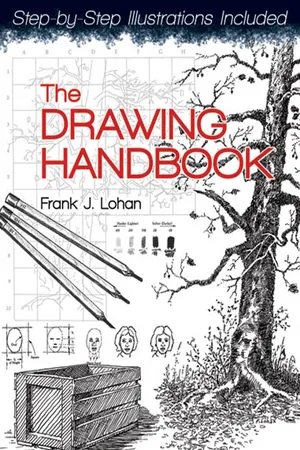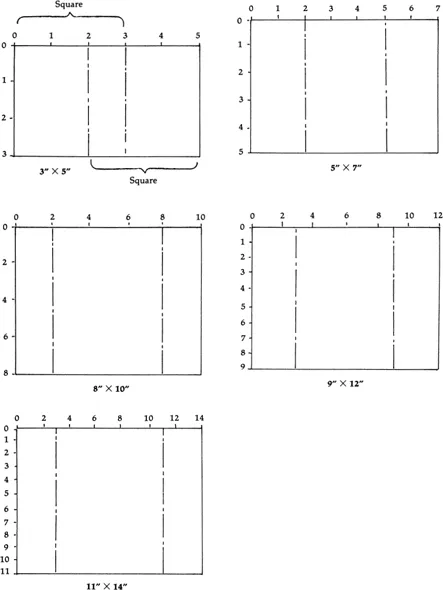
- 224 pages
- English
- ePUB (mobile friendly)
- Available on iOS & Android
eBook - ePub
The Drawing Handbook
About this book
Designed for beginning and amateur artists, this guide to the essentials of drawing features comprehensive, easy-to-follow lessons and more than 500 detailed illustrations. Frank Lohan, a renowned artist and popular instructor, conducts readers through each step of the creative process, from grasping the concepts of perspective and proportion to producing lifelike drawings of a variety of subjects — landscapes, architecture, animals, flowers, and faces.
Step-by-step exercises focus on attaining the fundamentals of composition, visualizing the geometry of the subject, working with perspective, and mastering drawing techniques for both pencil and pen and ink. Each exercise includes gridded outline compositions to help students develop their drawing abilities. Suggestions for the selection and use of tools will assist in achieving professional-quality results.
Step-by-step exercises focus on attaining the fundamentals of composition, visualizing the geometry of the subject, working with perspective, and mastering drawing techniques for both pencil and pen and ink. Each exercise includes gridded outline compositions to help students develop their drawing abilities. Suggestions for the selection and use of tools will assist in achieving professional-quality results.
Frequently asked questions
Yes, you can cancel anytime from the Subscription tab in your account settings on the Perlego website. Your subscription will stay active until the end of your current billing period. Learn how to cancel your subscription.
No, books cannot be downloaded as external files, such as PDFs, for use outside of Perlego. However, you can download books within the Perlego app for offline reading on mobile or tablet. Learn more here.
Perlego offers two plans: Essential and Complete
- Essential is ideal for learners and professionals who enjoy exploring a wide range of subjects. Access the Essential Library with 800,000+ trusted titles and best-sellers across business, personal growth, and the humanities. Includes unlimited reading time and Standard Read Aloud voice.
- Complete: Perfect for advanced learners and researchers needing full, unrestricted access. Unlock 1.4M+ books across hundreds of subjects, including academic and specialized titles. The Complete Plan also includes advanced features like Premium Read Aloud and Research Assistant.
We are an online textbook subscription service, where you can get access to an entire online library for less than the price of a single book per month. With over 1 million books across 1000+ topics, we’ve got you covered! Learn more here.
Look out for the read-aloud symbol on your next book to see if you can listen to it. The read-aloud tool reads text aloud for you, highlighting the text as it is being read. You can pause it, speed it up and slow it down. Learn more here.
Yes! You can use the Perlego app on both iOS or Android devices to read anytime, anywhere — even offline. Perfect for commutes or when you’re on the go.
Please note we cannot support devices running on iOS 13 and Android 7 or earlier. Learn more about using the app.
Please note we cannot support devices running on iOS 13 and Android 7 or earlier. Learn more about using the app.
Yes, you can access The Drawing Handbook by Frank J. Lohan in PDF and/or ePUB format, as well as other popular books in Art & Art Techniques. We have over one million books available in our catalogue for you to explore.
Information
Topic
ArtSubtopic
Art TechniquesPART 1
BASICS
Composition
Basic Drawing Tools and Materials
Some Fundamentals
Seeing the Geometry of Things
Drawing Techniques
This part of the handbook shows you some of the principle considerations of good composition; introduces you to the tools of drawing; shows you how to copy, reduce, enlarge, and transfer a composition to your final paper; gives you some simplified perspective hints and other things to consider when completing a drawing; explains how you can turn your works into notepaper easily and inexpensively; shows you how to see the geometric basis for natural forms (an essential capability if you want to do realistic drawings on your own); and illustrates some of the techniques of drawing with both the pen and with the pencil Part 1 ends with two exercises that will give you practice in creating form and texture with the pen and with the pencil You should try these exercises before you go on to Part 2, which covers actual drawing exercises.
1
Composition
About Composition
Unity and Variety in Composition
Drawing Orientation
Dividing the Drawing Space
Triangular Division
The Golden Section Division
Examples from Master Artists
Balance
Eye Movement and S Curves
About Composition
There is no single formula for creating well-composed drawings, just as there is no one technique for drawing realistic-looking trees, rocks, or other landscape elements. Awareness of the principles that are covered in this chapter, however, will make you more sensitive to the ways the space on your sheet or canvas can be divided. The application of some of the methods discussed will contribute to better composition in your work. Technique improvement will continue to come as you draw more and more.
Among other things, composition concerns the divisions of space on your pad or canvas and where in these divisions you place your key forms, your center of interest, and the more significant compositional elements. Placement is not everything, however; the tonal relationship among these elements is of equal importance and is part of what makes a composition “work.”
Any subject matter contains essential, subordinate (less important), and irrelevant features. As an artist you must be concerned with the way placement and tone are used to emphasize the essential and subordinate elements in your rendition of the subject. Irrelevant elements should be eliminated so as not to distract the viewer from the true message of your rendering. Your artistic judgment is called upon when you’re deciding whether an element is relevant to your message. For instance, do you keep or eliminate the television antenna on a farmhouse in a landscape? The answer depends on what you are trying to say. Of course, if your message is about the spoiling by careless persons of the rustic beauty of the land, then you include the television antennas, burger wrappers, used tires, and pop cans. If your message is about the beauty of the scene, then you eliminate those elements. With regard to your picture, you are God! You represent your little universe as you want it to be.
Unity and Variety in Composition
In order to please most critical eyes, a picture (drawing or painting) should have both unity and variety. If a picture is without unity, the viewer gets the impression of a disorganized muddle. If a picture is without variety, the viewer can quickly become bored as his or her eyes scan the picture.
If it has unity, a work’s elements all just seem to “hang together,” related, yet with appropriate significance or subordination of particular elements. Unity is achieved by proper choice of tone, subtle use of line (edges of forms), and overlap of picture elements, among other devices.
Variety is necessary to minimize boredom as the work is being viewed. A pleasing distribution of shapes on the canvas is essential to variety.
Drawing Orientation
Your paper or canvas may be oriented, or positioned, in many different ways. If it is square, it may be oriented upright, or it may be placed in a diamond orientation with opposite corners at the top and the bottom. It may be round or oval; if it is oval, it may be oriented with the long axis vertical or horizontal. Most drawings and paintings are rectangular or square. A vertically oriented rectangle is called a portrait orientation, and a horizontal rectangle is called a landscape orientation (see figure 1-1). Obviously, portrait orientation is not limited to portraits, nor is landscape orientation only for use with landscapes. These are simply names to differentiate between the two orientations of the paper or canvas.
There are some standard sizes used for paper, canvases, and frames, although any size or proportion can be used. (The use of a nonstandard size, however, generally means making or buying a custom-size frame.) The relative proportions of some of the smaller standard sizes are shown in figure 1-2: 3″ X 5″, 5″ X 7″, 8″ X 10″, 9″ X 12″, 11″ X 14″.

Figure 1-1
A Landscape orientation.
B Portrait orientation.
A Landscape orientation.
B Portrait orientation.

Figure 1-2
Division of some standard-size canvases into two overlapping squares, one from each short end.
Division of some standard-size canvases into two overlapping squares, one from each short end.
Dividing the Drawing Space
There are many mechanisms you can use to divide your picture area. The primary goal is to get variety into the arrangement of the space and thereby create interest for the viewer. Any mechanism or scheme that does this for you is valid. There is no one way that is “proper.” In fact, there are several ways to pleasingly divide the drawing space and determine key locations for important elements in your composition.
Also shown in figure 1-2 is one of the possible ways to divide the surface of a rectangular space—by the use of a square. Although these illustrations show landscape orientations, the same ideas apply to the portrait orientation. The square that starts the space division can be based on either of the two shorter sides of the paper. Use of either the left-hand square or the right-hand one gives an unequal division of the picture space, and unequal areas in your picture enhance interest. For example, if your landscape contains a prominent tree or other key figure, a good placement for it (although by no means the only good placement for it) is somewhere on the vertical line formed by one of the squares. This would put the figure off center, which is generally a good idea. The use of the squares is just one of several ways of locating appropriate off-center places, key locations for key elements in your composition.
Triangular Division
The off-center placement of the key element of a picture was not always considered the only proper placement. In the thirteenth and fourteenth centuries, it was frequently considered appropriate to place the central figure in a key location along the vertical centerline of the canvas. Often the central figure was placed more toward the top of the canvas with less important figures below in a triangular arrangement, sometimes in conjunction with a circle, square, or both (see figur...
Table of contents
- Cover Page
- Title Page
- Copyright Page
- Dedication
- Contents
- INTRODUCTION
- PART 1: BASICS
- PART 2. DRAWING EXERCISES
- BIBLIOGRAPHY
- OTHER BOOKS BY FRANK J. LOHAN
- INDEX
- Back Cover